Extremely Low-Frequency Magnetic Fields Exposure Measurement during Lessons in Elementary Schools
Abstract
1. Introduction
2. Materials and Methods
2.1. Research Design and Locations
2.2. Research Objects
2.3. Extremely Low-Frequency Magnetic Fields Measurement
2.4. Statistical Analysis
2.5. Ethical Considerations
3. Results
4. Discussion
5. Conclusions
Author Contributions
Funding
Acknowledgments
Conflicts of Interest
References
- World Health Organization. Extremely Low Frequency Fields; World Health Organization: Geneva, Switzerland, 2007. [Google Scholar]
- Kheifets, L.; Repacholi, M.; Saunders, R.; Van Deventer, E. The sensitivity of children to electromagnetic fields. Pediatrics 2005, 116, e303–e313. [Google Scholar] [CrossRef] [PubMed]
- Kheifets, L.; Afifi, A.A.; Shimkhada, R. Public health impact of extremely low-frequency electromagnetic fields. Environ. Health Perspect. 2006, 114, 1532–1537. [Google Scholar] [CrossRef] [PubMed]
- Terzi, M.; Ozberk, B.; Deniz, O.G.; Kaplan, S. The role of electromagnetic fields in neurological disorders. J. Chem. Neuroanat. 2016, 75, 77–84. [Google Scholar] [CrossRef] [PubMed]
- Johansson, O. Disturbance of the immune system by electromagnetic fields—A potentially underlying cause for cellular damage and tissue repair reduction which could lead to disease and impairment. Pathophysiology 2009, 16, 157–177. [Google Scholar] [CrossRef] [PubMed]
- Auvinen, A.; Linet, M.S.; Hatch, E.E.; Kleinerman, R.A.; Robison, L.L.; Kaune, W.T.; Misakian, M.; Niwa, S.; Wacholder, S.; Tarone, R.E. Extremely low-frequency magnetic fields and childhood acute lymphoblastic leukemia: An exploratory analysis of alternative exposure metrics. Am. J. Epidemiol. 2000, 152, 20–31. [Google Scholar] [CrossRef]
- Bell, J. Extremely low frequency (ELF) electromagnetic fields and leukaemia in children. Br. J. Cancer 1990, 62, 331–332. [Google Scholar] [CrossRef][Green Version]
- Coghill, R.U. Low-frequency electrical and magnetic fields near the beds of children with leukemia. Biofizika 1996, 41, 798–806. [Google Scholar]
- Feychting, M.A.; Ahlbom, A. Childhood leukemia and residential exposure to weak extremely low frequency magnetic fields. Environ. Health Perspect. 1995, 103 (Suppl. 2), 59–62. [Google Scholar] [CrossRef]
- Schmiedel, S.B.; Blettner, M. The association between extremely low-frequency electromagnetic fields and childhood leukaemia in epidemiology: Enough is enough. Br. J. Cancer 2010, 103, 931–932. [Google Scholar] [CrossRef]
- Schüz, J.A.; Ahlbom, A. Exposure to electromagnetic fields and the risk of childhood leukaemia: A review. Radiat. Prot. Dosim. 2008, 132, 202–211. [Google Scholar] [CrossRef]
- Eichholz, G.G. Non-ionizing radiation, part 1: Static and Extremely Low-Frequency (ELF) electric and magnetic fields. Health Phys. 2002, 83, 920. [Google Scholar] [CrossRef]
- Pedersen, C.; Johansen, C.; Schüz, J.; Olsen, J.H.; Raaschou-Nielsen, O. Residential exposure to extremely low-frequency magnetic fields and risk of childhood leukaemia, CNS tumour and lymphoma in Denmark. Br. J. Cancer 2015, 113, 1370–1374. [Google Scholar] [CrossRef] [PubMed]
- Ahlbom, A.D.; Day, N.; Feychting, M.; Roman, E.; Skinner, J.; Dockerty, J.; Linet, M.; McBride, M.; Michaelis, J.; Olsen, J.H.; et al. A pooled analysis of magnetic fields and childhood leukaemia. BT J. Cancer 2000, 83, 692–698. [Google Scholar] [CrossRef] [PubMed]
- Kheifets, L.A.; Ahlbom, A.; Crespi, C.M.; Draper, G.; Hagihara, J.; Lowenthal, R.M.; Mezei, G.; Oksuzyan, S.; Schüz, J.; Swanson, J.; et al. Pooled analysis of recent studies on magnetic fields and childhood leukaemia. Br. J. Cancer 2010, 103, 1128–1135. [Google Scholar] [CrossRef] [PubMed]
- Schüz, J.D.; Dasenbrock, C.; Ravazzani, P.; Röösli, M.; Schär, P.; Bounds, P.L.; Erdmann, F.; Borkhardt, A.; Cobaleda, C.; Fedrowitz, M.; et al. Extremely low-frequency magnetic fields and risk of childhood leukemia: A risk assessment by the ARIMMORA consortium. Bioelectromagnetics 2016, 37, 183–189. [Google Scholar] [CrossRef]
- Crasson, M. 50–60 Hz electric and magnetic field effects on cognitive function in humans: A review. Radiat. Protect. Dosim. 2003, 106, 333–340. [Google Scholar] [CrossRef]
- Preece, W.A.; Wesnes, K.A.; IWI, G.R. The effect of a 50 Hz magnetic field on cognitive function in humans. Int. J. Radiat. Biol. 1998, 74, 463–470. [Google Scholar]
- Huang, J.; Tang, T.; Hu, G.; Zheng, J.; Wang, Y.; Wang, Q.; Su, J.; Zou, Y.; Peng, X. Association between Exposure to Electromagnetic Fields from High Voltage Transmission Lines and Neurobehavioral Function in Children. PLoS ONE 2013, 8, e67284. [Google Scholar] [CrossRef]
- Pall, M.L. Microwave frequency electromagnetic fields (EMFs) produce widespread neuropsychiatric effects including depression. J. Chem. Neuroanat. 2016, 75, 43–51. [Google Scholar] [CrossRef]
- Warille, A.A.; Onger, M.E.; Turkmen, A.P.; Deniz, O.G.; Altun, G.; Yurt, K.K.; Altunkaynak, B.Z.; Kaplan, S. Controversies on electromagnetic field exposure and the nervous systems of children. Histol. Histopathol. 2016, 31, 461–468. [Google Scholar]
- International Commission on Non-Ionizing Radiation Protection (ICNIRP)1. Guidelines for limiting exposure to time-varying electric and magnetic fields (1 Hz–100 kHz). Health. Phys. 2010, 99, 818–836. [Google Scholar] [CrossRef]
- Institute of Electrical and Electronics Engineers (IEEE). C95.1-2019—IEEE Standard for Safety Levels with Respect to Human Exposure to Electric, Magnetic, and Electromagnetic Fields, 0 Hz to 300 GHz; IEEE: New York, NY, USA, 2019. [Google Scholar]
- Kaune, W.T.; Darby, S.D.; Gardner, S.N.; Hrubec, Z.; Iriye, R.N.; Linet, M.S. Development of a protocol for assessing time-eighted-average exposures of young children to power-frequency magnetic fields. Bioelectromagnetics 1994, 15, 33–51. [Google Scholar] [CrossRef] [PubMed]
- Tardón, A.; Velarde, H.; Rodriguez, P.; Moreno, S.; Raton, M.; Muñoz, J.; Fidalgo, A.; Kogevinas, M. Exposure to extremely low frequency magnetic fields among primary school children in Spain. J. Epidemiol. Commun. Health 2002, 56, 432–433. [Google Scholar] [CrossRef] [PubMed]
- Nassiri, P.; Monazzam, M.R.; Yunesian, M.; Sowlat, M.H.; Safari, M.H.; Fard, S.M.B.; Lotfi, S. Investigation of extremely low frequency magnetic field (ELF-MF) flux densities in the vicinity of schools in Tehran. World Appl. Sci. J. 2012, 20, 848–853. [Google Scholar]
- Ross, M.; Koren, S.; Persinger, M. Physiologically patterned weak magnetic fields applied over left frontal lobe increase acceptance of false statements as true. Electromagn. Biol. Med. 2008, 27, 365–371. [Google Scholar] [CrossRef]
- Gullotta, T.P.; Bloom, M. Encyclopedia of Primary Prevention and Health Promotion; Springer Science & Business Media: New York, NY, USA, 2003. [Google Scholar]
- Seomun, G.K.; Kim, Y.; Lee, J.A.; Jeong, K.; Park, S.A.; Kim, M.; Noh, W. Descriptive study of electromagnetic wave distribution for various seating positions: Using digital textbooks. J. Sch. Nurs. 2014, 30, 123–128. [Google Scholar] [CrossRef]
- Mezei, G.; Kheifets, L.I.; Nelson, L.M.; Mills, K.M.; Iriye, R.; Kelsey, J.L. Household appliance use and residential exposure to 60-Hz magnetic fields. J. Exp. Anal. Environ. Epidemiol. 2001, 11, 41–49. [Google Scholar] [CrossRef][Green Version]
- Marcilio, I.; Habermann, M.; Gouveia, N. Extremely low-frequency magnetic fields and health effects: Literature review. Rev. Bras. Epidemiol. 2009, 12, 105–123. [Google Scholar] [CrossRef][Green Version]
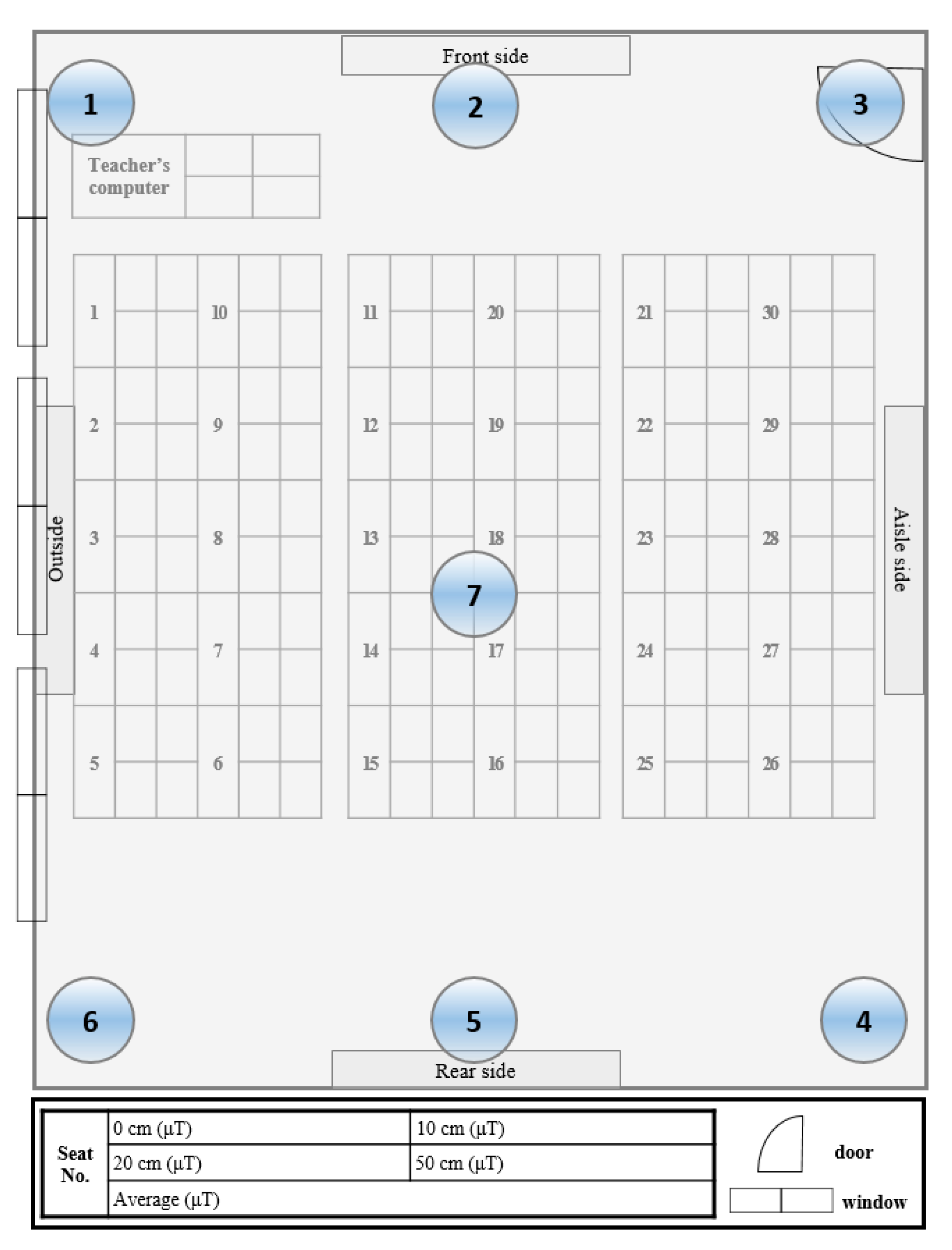
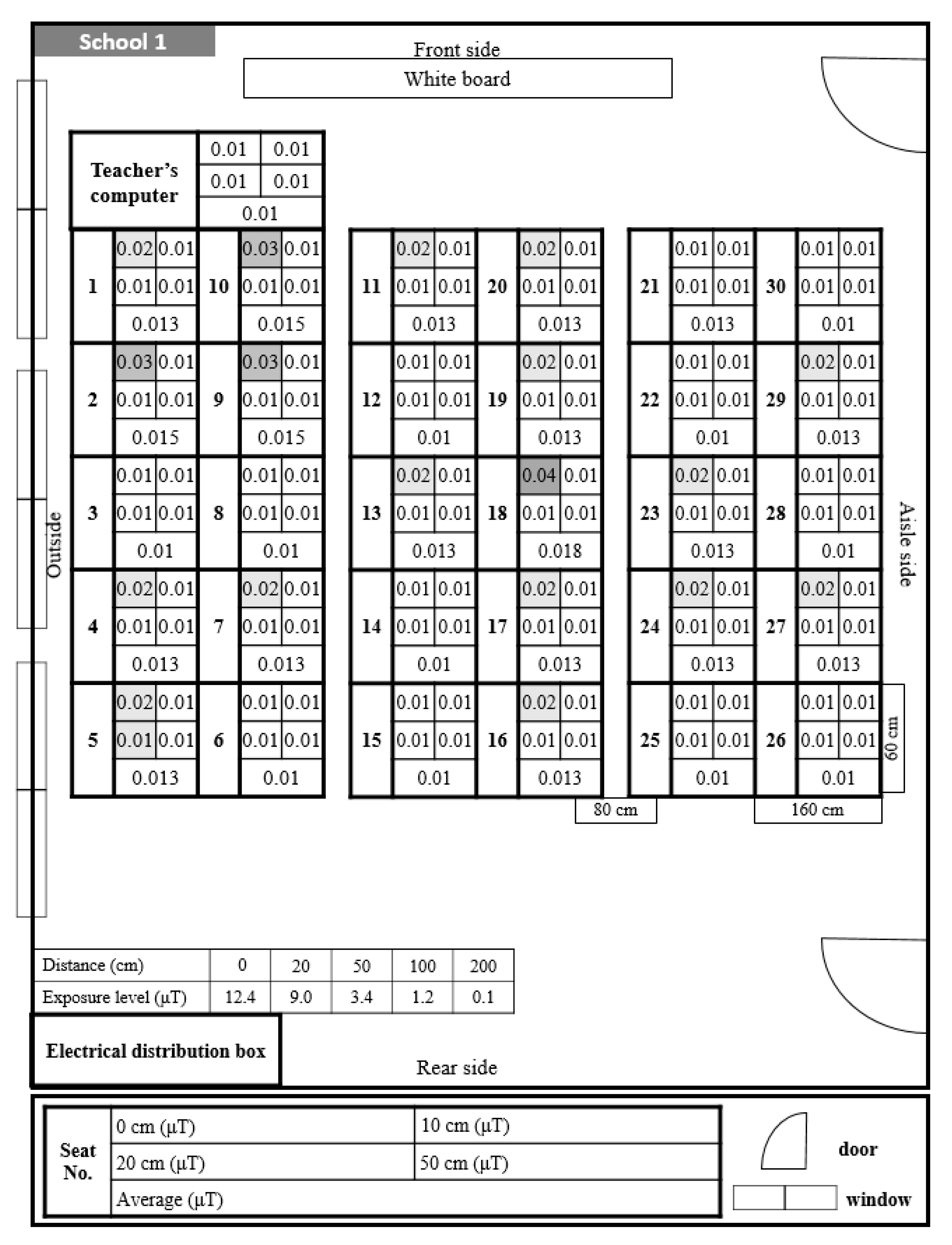
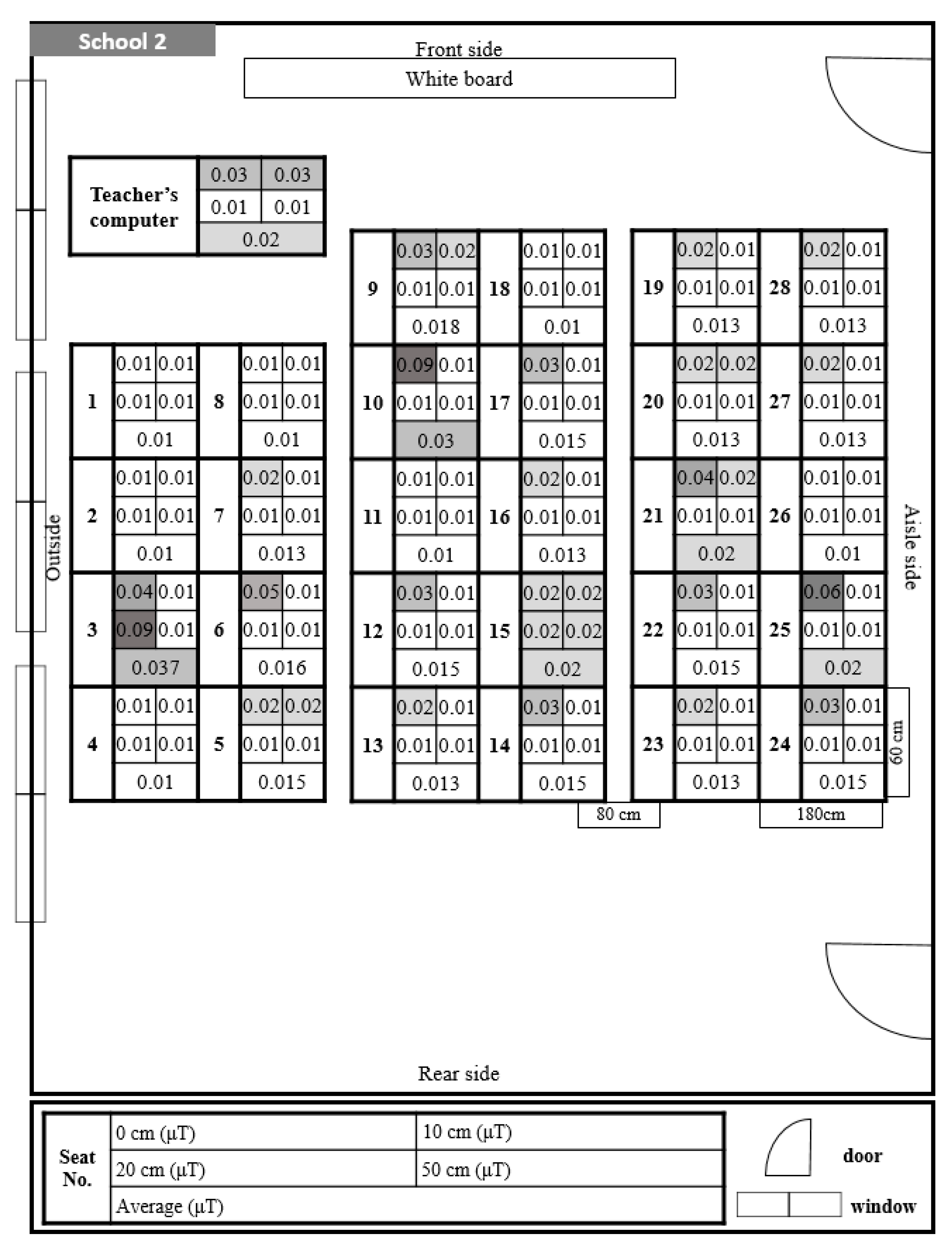
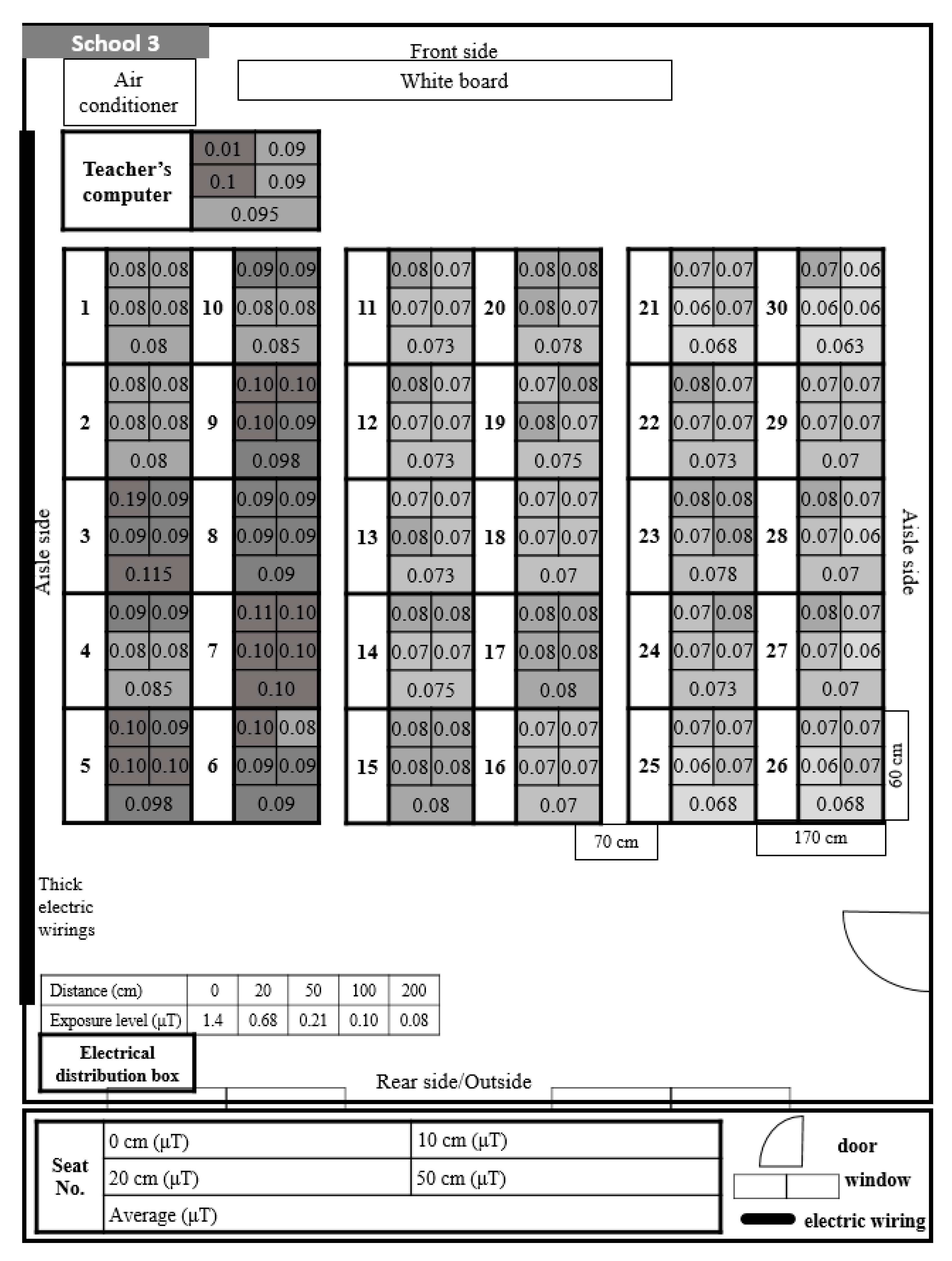
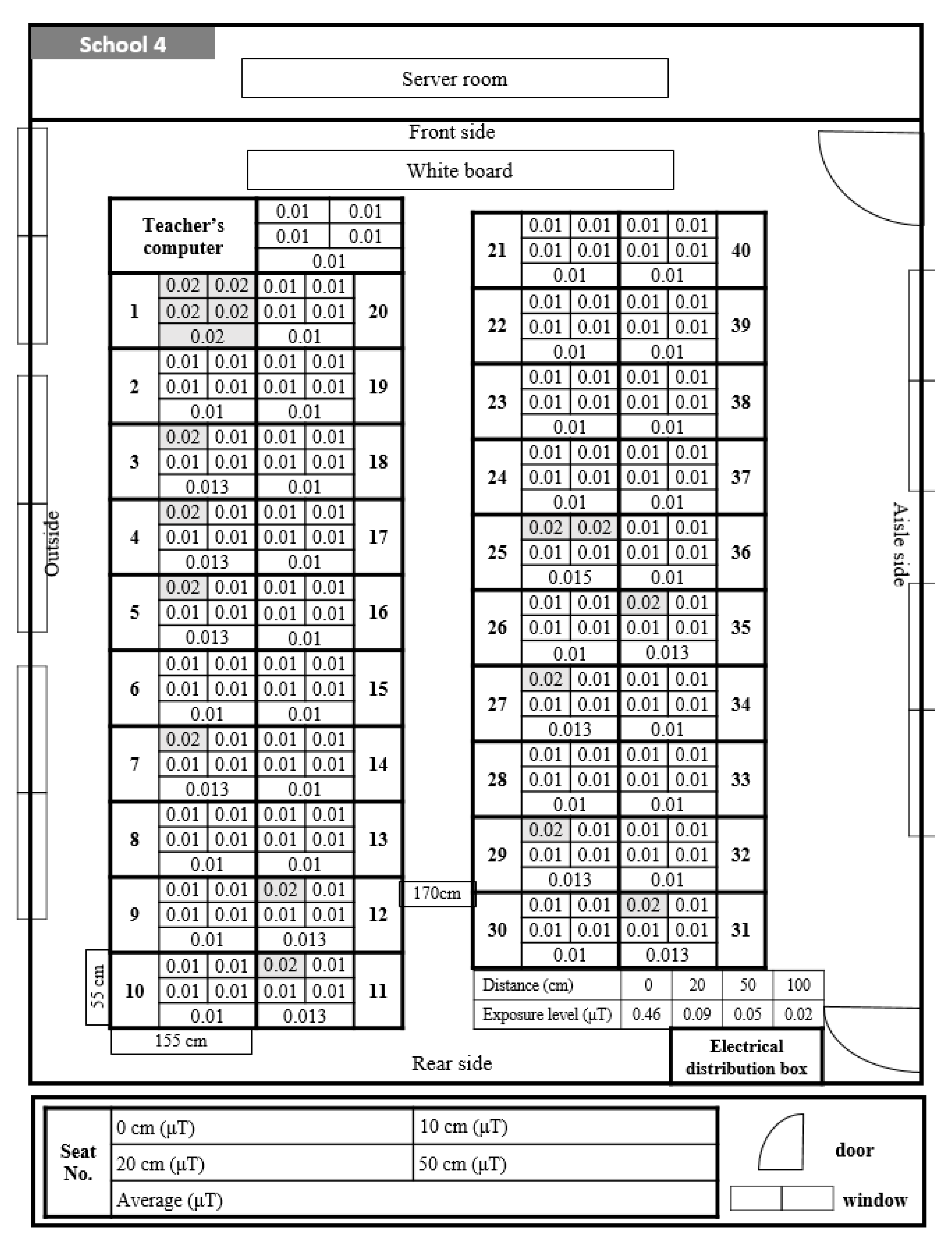
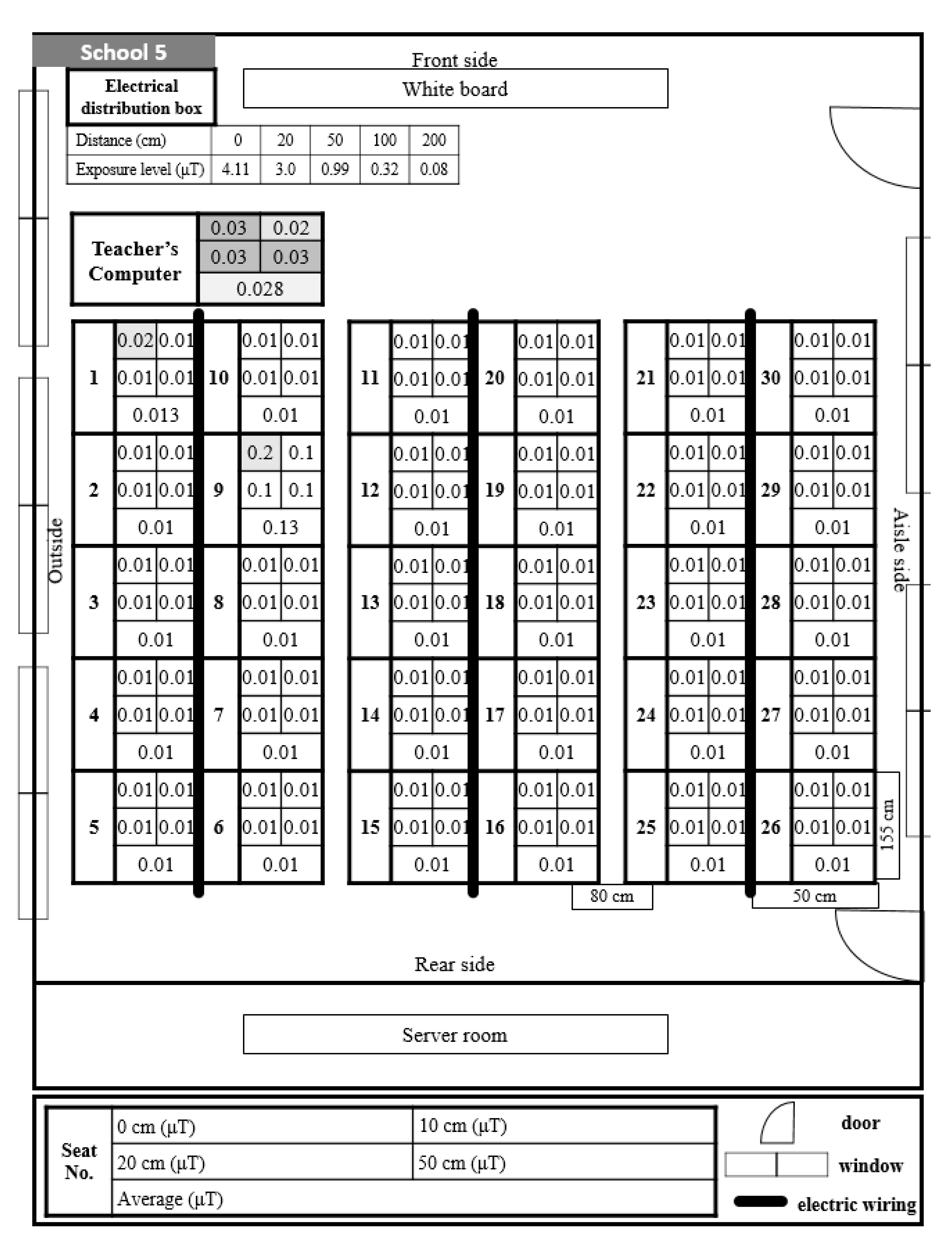
| Schools | Points | Level of Exposure to ELF-MFs (μT) | Mean of Level of Exposure to ELF-MFs | Remarks | No. of Seats | Temperature (°C) | |||
|---|---|---|---|---|---|---|---|---|---|
| 50 cm | 100 cm | 150 cm | |||||||
| 1 | 1 | 0.01 | 0.01 | 0.01 | 0.01 | 0.044 ± 0.066 | 30 | 24 | |
| 2 | 0.01 | 0.01 | 0.01 | 0.01 | |||||
| 3 | 0.01 | 0.01 | 0.01 | 0.01 | |||||
| 4 | 0.06 | 0.05 | 0.03 | 0.047 | Electrical wirings | ||||
| 5 | 0.11 | 0.18 | 0.28 | 0.19 | Electrical wirings | ||||
| 6 | 0.05 | 0.04 | 0.01 | 0.033 | Electrical distribution box | ||||
| 7 | 0.01 | 0.01 | 0.01 | 0.01 | |||||
| 2 | 1 | 0.01 | 0.01 | 0.01 | 0.01 | 0.019 ± 0.017 | 28 | 23 | |
| 2 | 0.01 | 0.01 | 0.01 | 0.01 | |||||
| 3 | 0.03 | 0.03 | 0.03 | 0.03 | Entrance | ||||
| 4 | 0.01 | 0.04 | 0.11 | 0.053 | Entrance | ||||
| 5 | 0.01 | 0.01 | 0.01 | 0.01 | |||||
| 6 | 0.01 | 0.01 | 0.01 | 0.01 | |||||
| 7 | 0.01 | 0.01 | 0.01 | 0.01 | |||||
| 3 | 1 | 0.09 | 0.15 | 0.16 | 0.133 | 0.091 ± 0.025 | Air conditioner | 30 | 25 |
| 2 | 0.09 | 0.09 | 0.09 | 0.09 | |||||
| 3 | 0.03 | 0.08 | 0.08 | 0.063 | |||||
| 4 | 0.13 | 0.09 | 0.09 | 0.103 | Electrical distribution box | ||||
| 5 | 0.03 | 0.08 | 0.08 | 0.063 | |||||
| 6 | 0.11 | 0.10 | 0.10 | 0.103 | Heater | ||||
| 7 | 0.08 | 0.08 | 0.08 | 0.08 | |||||
| 4A | 1 | 0.01 | 0.01 | 0.01 | 0.01 | 0.01 | 40 | 25 | |
| 2 | 0.01 | 0.01 | 0.01 | 0.01 | |||||
| 3 | 0.01 | 0.01 | 0.01 | 0.01 | |||||
| 4 | 0.01 | 0.01 | 0.01 | 0.01 | |||||
| 5 | 0.01 | 0.01 | 0.01 | 0.01 | |||||
| 6 | 0.01 | 0.01 | 0.01 | 0.01 | |||||
| 7 | 0.01 | 0.01 | 0.01 | 0.01 | |||||
| 4B | 1 | 0.19 | 0.05 | 0.03 | 0.09 | 0.021 ± 0.034 | Electrical distribution box | 30 | 24 |
| 2 | 0.01 | 0.01 | 0.01 | 0.01 | |||||
| 3 | 0.01 | 0.01 | 0.01 | 0.01 | |||||
| 4 | 0.01 | 0.01 | 0.01 | 0.01 | |||||
| 5 | 0.01 | 0.01 | 0.01 | 0.01 | |||||
| 6 | 0.01 | 0.01 | 0.01 | 0.01 | |||||
| 7 | 0.01 | 0.01 | 0.01 | 0.01 | |||||
© 2020 by the authors. Licensee MDPI, Basel, Switzerland. This article is an open access article distributed under the terms and conditions of the Creative Commons Attribution (CC BY) license (http://creativecommons.org/licenses/by/4.0/).
Share and Cite
Park, J.; Jeong, E.; Seomun, G. Extremely Low-Frequency Magnetic Fields Exposure Measurement during Lessons in Elementary Schools. Int. J. Environ. Res. Public Health 2020, 17, 5284. https://doi.org/10.3390/ijerph17155284
Park J, Jeong E, Seomun G. Extremely Low-Frequency Magnetic Fields Exposure Measurement during Lessons in Elementary Schools. International Journal of Environmental Research and Public Health. 2020; 17(15):5284. https://doi.org/10.3390/ijerph17155284
Chicago/Turabian StylePark, JinKyung, EunHye Jeong, and GyeongAe Seomun. 2020. "Extremely Low-Frequency Magnetic Fields Exposure Measurement during Lessons in Elementary Schools" International Journal of Environmental Research and Public Health 17, no. 15: 5284. https://doi.org/10.3390/ijerph17155284
APA StylePark, J., Jeong, E., & Seomun, G. (2020). Extremely Low-Frequency Magnetic Fields Exposure Measurement during Lessons in Elementary Schools. International Journal of Environmental Research and Public Health, 17(15), 5284. https://doi.org/10.3390/ijerph17155284





